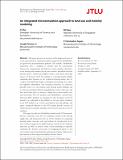| dc.contributor.author | Zhu, Yi | |
| dc.contributor.author | Diao, Mi | |
| dc.contributor.author | Ferreira, Joseph | |
| dc.contributor.author | Zegras, Christopher | |
| dc.date.accessioned | 2021-10-27T20:08:51Z | |
| dc.date.available | 2021-10-27T20:08:51Z | |
| dc.date.issued | 2018 | |
| dc.identifier.uri | https://hdl.handle.net/1721.1/134721 | |
| dc.description.abstract | © 2018 Yi Zhu, Mi Diao, Joseph Ferreira Jr., P. Christopher Zegras. This paper presents an overview of the design and status of a new type of land-use simulation module integrated into SimMobility, an agent-based microsimulation platform. The module, SimMobility Long-Term (LT), is designed to simulate how the interrelations between the transportation and land-use systems manifest themselves in the housing and commercial real estate markets, household and firm location choices, school and workplace choices, and vehicle ownership choices. At the heart of the LT simulator is a housing market module simulating daily dynamics in the residential housing market that (a) #x201C;awakens#x201D; households that begin searching for new housing; (b) accounts for eligibility, affordability, and screening constraints; (c) constructs plausible choice sets; (d) simulates daily housing market bidding; and (e) represents developer behavior regarding when, where, what type, and how much built space to construct, taking into account market cycle and uncertainty. The LT simulator and SimMobility’s activity-based, mid-term (MT) simulator are integrated in that the agents in the LT module (e.g., individuals in households) are the same agents simulated in the MT module (e.g., activity participation and trip-making), and agents’ simulated behaviors in the MT module provide measures of (utility-based) accessibility that figure into relevant decisions in the LT simulator. This paper describes the SimMobility model and the LT framework, presents estimation results for two component models of the housing supply side, and demonstrates the use of the simulator by comparing housing market outcomes with and without the introduction of one year’s worth of supply of new public housing. Overall, the LT simulator represents an effort to advance urban system modelling by explicitly simulating the dynamic interactions of disaggregated agents in real estate markets and encapsulating the information of agents’ daily activity participation in their long-term mobility-relevant choices. | |
| dc.language.iso | en | |
| dc.publisher | Center for Transportation Studies | |
| dc.relation.isversionof | 10.5198/JTLU.2018.1186 | |
| dc.rights | Creative Commons Attribution NonCommercial License 4.0 | |
| dc.rights.uri | https://creativecommons.org/licenses/by-nc/4.0/ | |
| dc.source | Journal of Transport and Land Use | |
| dc.title | An integrated microsimulation approach to land-use and mobility modeling | |
| dc.type | Article | |
| dc.contributor.department | Massachusetts Institute of Technology. Department of Urban Studies and Planning | |
| dc.contributor.department | Massachusetts Institute of Technology. School of Architecture and Planning | |
| dc.relation.journal | Journal of Transport and Land Use | |
| dc.eprint.version | Final published version | |
| dc.type.uri | http://purl.org/eprint/type/JournalArticle | |
| eprint.status | http://purl.org/eprint/status/PeerReviewed | |
| dc.date.updated | 2019-06-07T16:53:46Z | |
| dspace.orderedauthors | Zhu, Y; Diao, M; Ferreira, J; Zegras, C | |
| dspace.date.submission | 2019-06-07T16:53:47Z | |
| mit.journal.volume | 11 | |
| mit.journal.issue | 1 | |
| mit.metadata.status | Authority Work and Publication Information Needed | |
